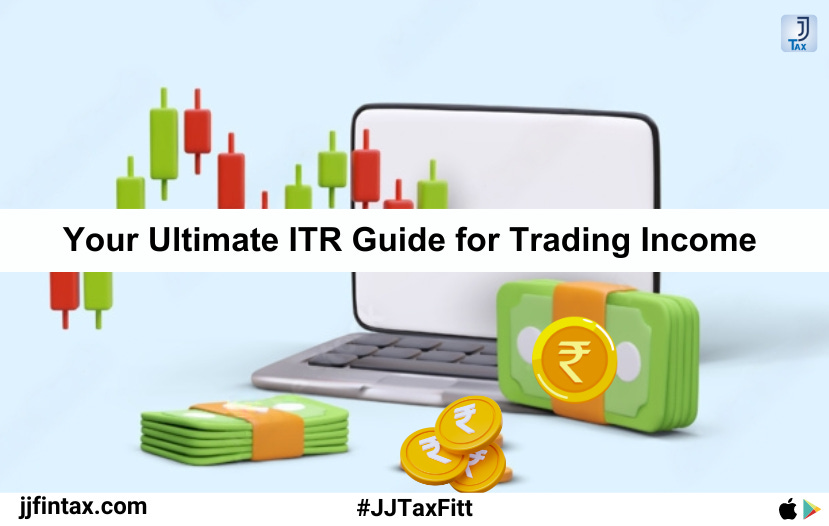From Trading Desk to Tax Desk🖥️

In the fast-paced world of securities trading, where every tick of the market move can mean a profit or a loss, there’s also a crucial need to manage taxes responsibly. Welcome to the world of tax filing for traders—a complex but rewarding endeavour if approached with the right knowledge and care.
In this edition of the JJ Tax Newsletter,we guide you through tax season for traders. The rules are complex, but understanding them can lead to significant financial benefits. We’ll break down the process of calculating income, claiming expenses, and filing the correct tax forms to help you navigate this financial landscape with ease.
How To Compute Income From F&O Trades?
Income from F&O trades is computed based on the net profit or loss incurred during the trading period, taking into account the following key factors:
Profit and Loss Statement: The cornerstone of income computation in F&O trading lies in the meticulous tracking of profits and losses from individual trades. Each transaction, whether a gain or a loss, must be accurately recorded to determine the net income derived from F&O trades.
Mark-to-Market (MTM) Accounting: In accordance with tax regulations, traders are required to mark their F&O positions to market at the end of each trading day. This process, known as mark-to-market accounting, ensures that traders account for unrealized gains or losses on open positions, which are then reflected in their income statement.
Settlement and Realization: Income from F&O trades is realized upon settlement of contracts or closure of positions. It is crucial for traders to distinguish between realized and unrealized gains/losses, as only realized income is taxable under the Income Tax Act.
Offsetting Losses: One of the key benefits of trading in F&O contracts is the ability to offset losses against gains from other F&O trades or capital gains from other asset classes. Traders can carry forward losses to subsequent years to offset against future gains, thereby reducing their tax liability.
How To Claim Expenses?
Here's a closer look at how traders can claim expense in F&O trading:
Brokerage Fees: The bread and butter of trading expenses, brokerage fees represent the cost of executing trades through a brokerage platform. Whether it's a flat fee per trade or a percentage of the transaction value, brokerage fees are fully deductible as business expenses, reducing taxable income and increasing overall returns.
Data and Software Costs: In today's digital age, access to real-time market data and sophisticated trading software is essential for staying ahead of the curve. Fortunately, these expenses are fully deductible as business expenses, allowing traders to claim the cost of subscriptions to data feeds, charting tools, and trading platforms.
Professional Services: For traders who rely on the expertise of tax consultants, accountants, or financial advisors, the fees paid for these services are fully deductible as business expenses. Whether it's tax planning, accounting services, or investment advice, traders can claim these expenses to reduce their taxable income and optimize their returns.
Office Expenses: Traders who maintain a dedicated workspace for their trading activities can claim a portion of their rent, utilities, and other office expenses as business deductions. Whether it's a home office or a dedicated trading desk, these expenses are fully deductible, providing traders with additional opportunities to reduce their tax liability.
Which ITR Is Applicable For Traders?
For security traders, determining the applicable Income Tax Return (ITR) form is pivotal in ensuring accurate disclosure of income. Typically, ITR 3 is the go-to form for those with business income, encompassing various sources such as salary, house property, and other avenues alongside F&O income.
However, if opting for a presumptive income scheme, where profits are declared at a fixed percentage of turnover (6% for security traders), ITR 4 comes into play. Yet, if F&O income is declared as presumptive business alongside capital gains, ITR 3 becomes necessary. Thus, meticulous consideration of income sources and declaration methods dictates the appropriate ITR form for security traders.
How to Report Losses in F&O?
Reporting losses from F&O trades is a crucial aspect of tax compliance, regardless of whether they resulted in profit or loss. While it may seem tempting to omit reporting losses, it is mandatory to disclose them in your Income Tax Return (ITR) to avoid potential notices from the Income Tax Department.
Depositories are obligated to report details of F&O trades to the Income Tax Department via SFT filing, making non-declaration a risky proposition. However, there are benefits to reporting losses that many overlook. Losses from F&O trading can be offset against other sources of income, except for salary income. This means that losses can reduce your overall taxable income, potentially resulting in lower tax liability.
Furthermore, any unabsorbed losses can be carried forward for up to eight years, although they can only be set off against business income in subsequent years, not against any other income. These details are reflected in Schedule CFL of your ITR form, underscoring the importance of accurate reporting to optimize tax planning and minimize liabilities.
We know that tax season can be daunting, but it doesn't have to be. JJ Tax is here to help.
So let's tackle tax season together, armed with knowledge, determination, and a dash of optimism. With our help, you can navigate the twists and turns of tax filing with confidence, knowing that you're making the best decisions for your financial future.
Here's to a successful tax season and a brighter financial future ahead.

